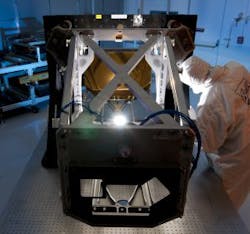With integration complete, auxilliary mirrors on the James Webb Space Telescope are ready for test
Redondo Beach, CA--The auxiliary mirrors that focus the light from the primary mirror into the science instruments on NASA's James Webb Space Telescope (JWST) have been integrated into the aft-optics subsystem (AOS) by Ball Aerospace (NASDAQ:BLL; Boulder, CO) and are ready for the next level of testing.
"Our teammates at Ball have done an outstanding job on all the mirror optics, including this integration," said Scott Texter, Webb Optical Telescope Element manager, Northrop Grumman Aerospace Systems (NYSE:NOC). "It's the last major effort in manufacturing Webb's large optical components and represents a significant milestone for the observatory." Northrop Grumman is the prime contractor responsible for designing and developing the telescope for NASA's Goddard Space Flight Center (Greenbelt, MD).
The newly integrated optics consist of the tertiary mirror and the fine steering mirror, comprising the telescope's AOS. The mirrors are encased in a precision beryllium rectangular optical bench installed at the center of Webb's primary mirror. The AOS is surrounded by a shroud to keep out stray light and two large radiator panels to keep it cold.
This subsystem collects and focuses the light from the secondary mirror and feeds it into the science instruments. Integration, which was completed in November and December 2011, consists of attaching several smaller assemblies to the optical bench and then aligning the two mirrors to one another.
"The challenge is to get the two mirrors properly aligned and to know where they are at ambient temperatures," said Sokol. "It's very important to know where they will move to once they reach the telescope's hypercold operating temperature of 40 degrees Kelvin or -387 degrees Fahrenheit."
The AOS will undergo a series of tests that will show that it will withstand the rigorous vibration environment of the rocket launch and still be precisely aligned and function as it should at its cold operating temperature in space. It will take nine and a half weeks to complete this testing, which is slated to start in May.
About the Author

Conard Holton
Conard Holton has 25 years of science and technology editing and writing experience. He was formerly a staff member and consultant for government agencies such as the New York State Energy Research and Development Authority and the International Atomic Energy Agency, and engineering companies such as Bechtel. He joined Laser Focus World in 1997 as senior editor, becoming editor in chief of WDM Solutions, which he founded in 1999. In 2003 he joined Vision Systems Design as editor in chief, while continuing as contributing editor at Laser Focus World. Conard became editor in chief of Laser Focus World in August 2011, a role in which he served through August 2018. He then served as Editor at Large for Laser Focus World and Co-Chair of the Lasers & Photonics Marketplace Seminar from August 2018 through January 2022. He received his B.A. from the University of Pennsylvania, with additional studies at the Colorado School of Mines and Medill School of Journalism at Northwestern University.
